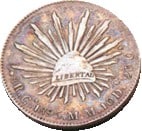Wouldn’t it be nice to unexpectedly unearth a pot of gold while digging in the dirt behind your house? This fantasy is alive and well amongst the residents of Juluchuca, Mexico. While working in Playa Viva’s archeological site, I found a rather large pre-Hispanic clay pot. As we were carefully digging it out of the hillside, several of the workers came to tell me their gold stories.
There seemed to be quite a few people who knew people who had found clay pots full of gold. Here is one such story: It was full moon at the Salina (place were salt is made), and Mr. Martin Sosa and his wife were working on that night preparing the pools to evaporate the salty water. Digging out sand and limestone makes these pools. Suddenly, as they were digging, the shovel hit a clay pot. According to the story, Mr. Sosa had an impulse of curiosity and broke it open to find golden coins inside. He immediately started together them while trying to ignore the strong smell of gas that was coming from the pot.
According to this account, Mr. Sosa died after one week in consequence of that gas, and the ones to get the benefit of that gold were his siblings Lorenzo and Silvano who sold one by one at 300 pesos to a dentist in near by town Petatlan and used the money to fuel their drinking and gambling habits.
Here is an image of one of the coins found my Mr. Sosa:
The coin is from 1823 with an image of a nightcap and sunrays, which represents the freedom of México after getting the independence in 1821. It’s the first of its kind to have an image of the Eagle, Mexico’s national seal, on the back. In the 1820s Mexico was fraught with internal wars. Since power was continuously changing hands, it was common practice to hide your money if you happen to find yourself on the wrong side.


